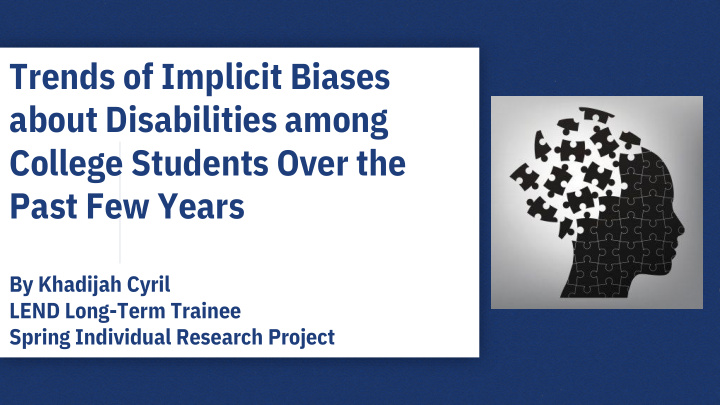



Trends of Implicit Biases about Disabilities among College Students Over the Past Few Years By Khadijah Cyril LEND Long-Term Trainee Spring Individual Research Project
RAISE YOUR HAND IF YOU DO NOT HAVE ANY BIASES
◎ Individuals’ process 11 million bits of information every second ◎ A prejudiced subconscious process that constantly IMPLICIT influences individual’s feelings, BIAS thought patterns, actions, and behaviors. ◎ It is usually rooted in prejudices about specific groups of people and is often subtle and unintended (Goff, Eberhardt, Williams, & Jackson, 2008). Staats, 2016)
Defeating Unconscious Bias Project Implicit, Harvard University https://www.projectimplicit.net/index.html The Implicit Association Test (IAT) Anthony Greenwald et. Al 5 Measures the strength of automatic associations people have in their minds.
DISABILITY - IMPLICIT ASSOCIATION TEST Disability Good Words Bad Words Pleasure Yucky Glad Nasty Happy Disgust Cheerful Awful Ability Enjoy Despise 6 Fantastic Selfish Triumph Abuse Terrific Helpful (Xu, F.K., Nosek, B. A., Greenwald, A. G., Lafora, N., & Axt, J, 2019)
Research Question: Using the Disability - IAT, what are the trends of college students implicit biases towards disabilities? Are implicit biases increasing, decreasing, or remaining the same? Hypothesis: Implicit biases towards disabilities will decrease because there is more access to education around disabilities. Thus, the more college students become informed and exposed to differences, the less biases they possess.
Secondary Data ● Only participants from ages 18 to 22 years ● old considered Must have stated reason for taking test Methods ○ as “assignment for school” Data from 2016 to 2018 ● Ran One Way ANOVA for the past 3 years ●
DESCRIPTIVE STATISTICS! ◎ N: 26,247 ◎ Age: 18 to 22 years old ◎ Males: 5,900 (22.5%) 9 ◎ Females: 20, 323 (77.4%) ◎ Disability or Learning Difficulty Status ◎ Yes (20.1%) ◎ No (79.0%)
COLLEGE STUDENTS’ DISABILITY OR LEARNING DIFFICULTY TYPE 10
RACIAL MAKEUP OF COLLEGE STUDENTS 11
Overall Implicit D Scores Results Of 12 College Students P < .021* only from 2017 to 2018
Overall Implicit D Scores in the Last 14 years Results Of Entire 13 Population P < .0001* except from year 2004 to 2005
Discussion ◎ Implicit biases are pervasive and automatic thoughts, feelings, and behaviors about individuals with disabilities ◎ Implicit biases about disabilities is trending downward in college students, but upward for the general population. ◎ Evidence-based education interventions to inform and educate people about disabilities is important to reduce biases.
Limitations Future Directions ◎ Secondary Data ◎ Follow data to see if downward trend of ◎ Generalizability of results implicit biases among should be taken with college students continue caution (e.g use of signs) ◎ Evaluate education ◎ Not enough years of data interventions to teach the to establish a pattern with general population about college students individuals with disability ◎ Missing Data
Banaji, M. R., & Greenwald, A. G. (2016). Blindspot: Hidden biases of References good people . Bantam. Goff, P. A., Eberhardt, J. L., Williams, M. J., & Jackson, M. C. (2008). Not yet human: implicit knowledge, historical dehumanization, and contemporary consequences. Journal of personality and social psychology , 94 (2), 292. 16 Staats, C. (2016). Understanding implicit bias: What educators should know. American Educator, 29-43. Xu, F.K., Nosek, B. A., Greenwald, A. G., Lafora, N., & Axt, J, (2019) Project implicit bias. Center for Open Science. University of Virginia
Educational Video From Individuals with Place your screenshot here 17 Disabilities
Recommend
More recommend